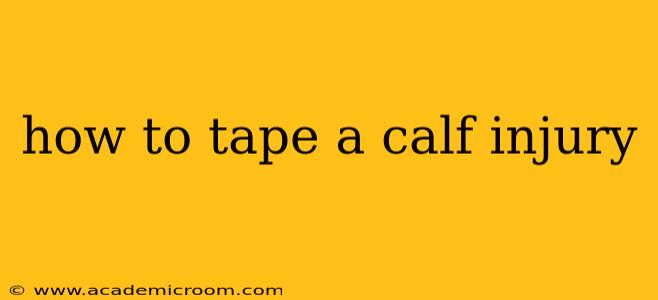Calf injuries, ranging from mild strains to more serious tears, are common, especially among athletes and those involved in physically demanding activities. Knowing how to properly tape a calf injury can provide support, reduce pain, and help prevent further damage. However, it's crucial to remember that taping is a supportive measure and not a replacement for proper medical evaluation and treatment. This guide will walk you through the process, but always consult a doctor or physical therapist for diagnosis and personalized advice.
What Type of Calf Injury Do You Have?
Before we delve into taping techniques, it's essential to understand the nature of your injury. Different injuries may require slightly different taping approaches. Common calf injuries include:
- Muscle Strain: This ranges from a mild pull (grade 1) to a partial tear (grade 2) or a complete tear (grade 3). Symptoms include pain, swelling, bruising, and difficulty walking.
- Muscle Tear: A more severe injury involving a rupture of the muscle fibers. This often results in significant pain, swelling, and limited mobility.
- Tendinitis: Inflammation of the tendons in the calf, often causing pain and stiffness.
- Achilles Tendinitis: Inflammation of the Achilles tendon, causing pain in the back of the heel and lower calf.
Note: If you experience severe pain, significant swelling, inability to bear weight, or a noticeable deformity, seek immediate medical attention.
How to Tape a Calf Muscle Strain or Tear (Basic Technique)
This technique provides general support and compression. Remember, this is a simplified approach; professional taping may differ depending on the specific injury and individual needs.
Materials You'll Need:
- Athletic Tape: Choose a high-quality athletic tape that is breathable and provides good adhesion. Avoid using inflexible or overly sticky tapes.
- Scissors: For cutting the tape to the appropriate length.
- Underwrap (optional): This can protect the skin and improve tape adhesion, especially for those with sensitive skin.
Step-by-Step Instructions:
- Prepare the Skin: Clean and dry the skin thoroughly. If using underwrap, apply it smoothly to the area.
- Anchor: Start by anchoring the tape just below the knee, wrapping it around the leg a few times for secure base.
- Spiral Application: Apply strips of tape spirally up the calf, ensuring that each strip overlaps the previous one by about half its width. Maintain moderate tension to provide support without restricting blood flow.
- Finishing the Tape: Continue the spiral application up to the lower part of the gastrocnemius muscle (the larger calf muscle). Secure the end of the final strip by wrapping it around the leg a few times.
What are the Different Types of Taping Techniques for Calf Injuries?
Several taping techniques exist, each offering unique benefits depending on the specific injury and desired outcome. While a basic spiral application is common, other advanced techniques may include:
- Functional Taping: This method focuses on supporting specific muscle actions and movements. It often involves strategically placed strips to provide targeted support. It's best learned from a physical therapist or athletic trainer.
- Kinesio Taping: This uses elastic tape applied with minimal tension, designed to lift the skin and improve blood flow, potentially reducing pain and improving range of motion. Proper application requires specialized training.
How Long Should I Keep the Tape on?
The duration of tape application depends on the severity of the injury and individual response. Generally, it's recommended to keep the tape on for a few hours to a day, or as advised by your physician or physical therapist. Remove the tape carefully to avoid skin irritation. You can reapply the tape as needed, but avoid overusing it.
What are the Benefits of Taping a Calf Injury?
Taping a calf injury offers several potential benefits:
- Pain Reduction: Provides compression that can help reduce pain and inflammation.
- Support and Stability: Helps support the injured muscles and tendons, reducing strain during movement.
- Improved Proprioception: Enhanced awareness of the injured area's position and movement.
- Reduced Swelling: Compression helps to minimize swelling.
When Should I See a Doctor or Physical Therapist for a Calf Injury?
It's crucial to seek professional medical attention if:
- The pain is severe.
- There is significant swelling.
- You're unable to bear weight on your leg.
- You notice a deformity in your calf.
- Symptoms don't improve after a few days of rest and self-care.
Remember, this guide provides general information. Always consult a healthcare professional for proper diagnosis and treatment of your calf injury. They can assess your specific needs and recommend the most appropriate taping technique or other interventions. Self-treating without proper evaluation could worsen the injury.
